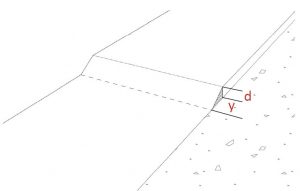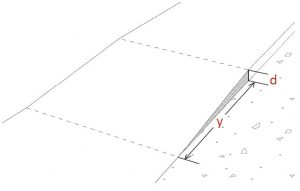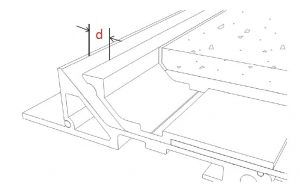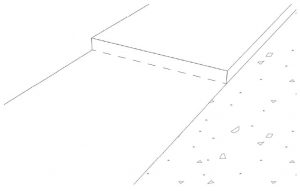Accessibility
Specifiers often overlook the fact that expansion joints in floors can fail to meet the demands of current international Disability legislation.
Accessibility and International Disability Legislation
Three pieces of Disability legislation serve to present the worst case scenario for any designer specifying an expansion joint in a floor. These are respectively the Americans with Disabilities Act (ADA), the US Department of Transport’s “Standards for Transportation Facilities” and the UK Building Regulations Part M: 1.26. With regard to small steps and gratings interrupting a floor’s surface, American’s with Disabilities Act (ADA) requirements are the most rigorous of their type.
The figures opposite illustrate ADA requirements:
Figure 1
A step cannot exceed 6.4mm in height without the edges of the step being bevelled.
 Figure 2
Figure 2
A step greater than 1/4 in (6.4mm) and up to 1/2 in (13 mm) in height must be sloped with a height to base ratio of 1:2 or less.
 Figure 3
Figure 3
When vertical steps are > 13mm and ≤75mm UK Building Regulations apply and these require that any such ramp or slope has a gradient of 1: 12 or greate
 Figuur 4
Figuur 4
As a further clarification of ADA regulations the US Department of Transport’s “Standards for Transportation Facilities” advise that gratings located in walking surfaces shall have spaces no greater than 1/2 in (13 mm) wide in any one direction.
Where a specifier encounters floors having a vertical deflection in excess of ¼ in (6.4mm) or a gap wider than ½” (13mm) they should seek to speak to the Technical Engineering department of a reputable expansion joint manufacturer.
Compliance Stamp
 Products marked with the stamp shown below are fully compliant with all current Disability legislation. The exception
Products marked with the stamp shown below are fully compliant with all current Disability legislation. The exception
to this is situations where vertical deflection across the expansion gap is greater than 13mm in which case a joint may need to be designed to meet both the deflection and accessibility requirements.








